S. F.
By Frank Swies
Reprinted from "Crown Jewels of the Wire", March 2006, page 8
What's it mean and Where'd it come from
Glass insulators embossed with a simple S.F. have long been a curiosity among
insulator collectors. For many years, the S.F. embossing was believed to have
referred to San Francisco and there is some evidence to prompt this belief.
There is another theory; that S.F. referred to the S. Fobes Company. We also
hear that the S.F. was a users mark for the Santa Fe Railway. Brookfield and
California Glass Works are sometimes mentioned as possible sources.
In the "Court of Popular Opinion" it appears that the jury is still
out. It may be well to review what we know and what we think we know about these
various beliefs.
The Case for San Francisco
Perhaps the earliest known S.F. embossing appears on the CD123 insulators
made for the Electrical Construction and Machinery Company of San Francisco
(1871-1877). Their embossing of E.C&.M.S.F. seems quite obvious as to its
meaning; the full name of the company includes its location.(11) The time frame
poses a problem. The existing E.C&.M.S.F. insulators were all produced from
two-part molds. All of the other known styles of S.F. embossed insulators (CD
102 & 112) are products of three-part molds (post 1879). The CD123 is
threaded, as are the CD102 & 112, which would date it some time after
Cauvet's threading patent (c.1865). The manufacturer of the CD123 E.C&.M.S.F.
is believed to have been Pacific Glass Works of San Francisco.(3) They were
absorbed by San Francisco Glass Works in 1876(1).
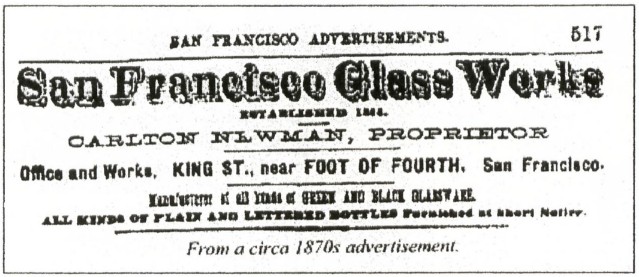
The Pacific Glass Works was is considered to be the first successful San
Francisco glass company. Baker & Cuttings, an earlier firm, had failed in
1860 after less than one year of operation. They produced a wide variety of glass products which
included wine, liquor, medicine and chemical bottles as well as insulators
(types unknown) and fruit jars (1). In 1876 they consolidated with the San
Francisco Glass Works. The resulting company was known as the Pacific and San
Francisco Glass Works.(2)
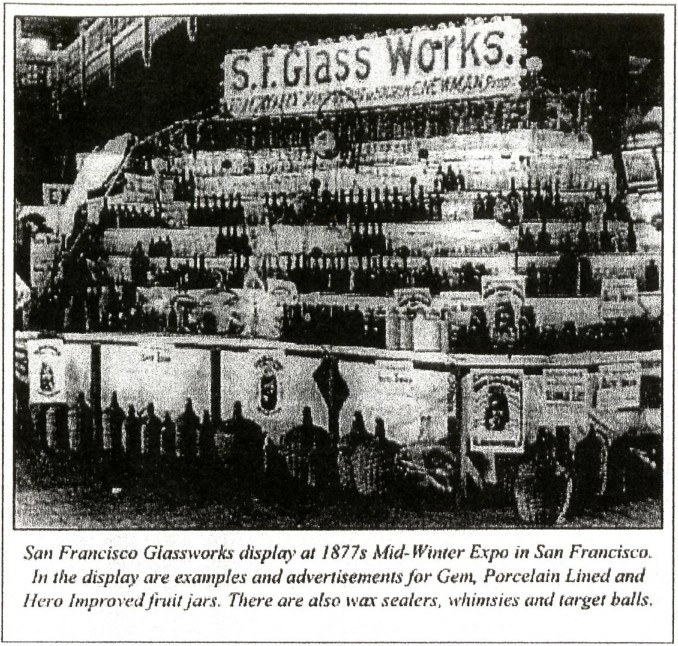
This advertisement and photo illustrate their use of S.F. as an abbreviation
for San Francisco.
Source: Bottles and Extras, July 1995 Magazine
If the Pacific Glass Works did produce S.F. embossed insulators then the
quest for a manufacturer could well be ended. However, all of the known CD 102
and 112 S.F. insulators were products of three-part molds. Pacific Glass would
have used two-part molds since it was founded in 1862 and three-part molds were
not common until the 1880's. The plant was updated in 1886 and three-part mold
machines may have been installed at that time.
The Case for California Glass Works
Robert P. Frist recognized that the market for glass sales was not limited to
insulators alone. There was great demand for West Coast produced bottles, jars, vials, etc. due to the high cost of shipping. The estimated market demand for
telephone, telegraph, power and lighting insulators was 18,000,000 annually by
year's end 1912.(4) Thus, in 1912, Frist formed The California Glass Insulator
Company located at W. Anaheim Rd. and Hayes S1. in Long Beach, California. In
1914 it became known as the California Glass Works. It was reported that the
Pacific Electric Railway, the Southern Pacific Railroad, The Santa Fe Railway,
Pacific Light and Power and the California Edison Company purchased all of their
glass supplies from the California Glass Works. Further, the California Glass
Works were reported as contracting with a "San Francisco firm" to
provide 3,000,000 insulators annually.(4) This insulator heyday was short lived,
however, because the plant was destroyed by flood in 1916 and never reopened.(4)
The Case for S. Fobes
One existing belief is that the S.F. embossing is a user's mark of a west
coast distributor named "S. Fobes." This belief seems plausible since
most sightings of S.F. insulators have occurred in western states. It is said
that this company had offices in San Francisco, however, city directories of the
1900 through 1910 period do not include any listing of " S. Fobes" or
an "S. Fobes Company." Indeed, inquiries directed to numerous State
chambers of commerce, historic societies and State library archives failed to
produce any recognition of an "S. Fobes" Company.
This we do know: by 1887, Edward N. Fobes, and his brother Walter R. Fobes
had made their way to Seattle, Washington from their home in Rochester, N.Y.
Together with a partner Edward C. Niles they started the Fobes Brothers &
Niles Supply Company in 1889. The 1890 Seattle City directory showed their
business as providing typewriters, cash registers and bicycle sundries. By 1900,
the partnership with Niles was dissolved and the company was known simply as
Fobes Brothers Cycle and Supply. In 1904 they included electrical machinery and
supplies in their product line. By then they were known as the Fobes Supply
Company.
Several product catalogs were issued. Catalog # 21 indicated that the company
was an agent for Westinghouse Electric & Mfg. Co. (Illustration next page)
Hemingray insulators were offered. By 1934, catalog #58 was issued and showed
that Hemingray insulators were still offered, also, that the company was now a
"Division of Westinghouse Electric Supply Company." (Westinghouse had
purchased all of the assets of the Fobes Supply Co. in 1922.)
There is no mention of an S. Fobes in any of the Fobes Company archives. The
1910 Seattle census recorded a Stuart F. Fobes, (Architect), age 38, as head of
a household. If the mathematics are correct it would mean that Stuart was about
16 years old when Fobes Brothers and Niles was established in 1889. We find
record of a Sgt. Simon Fobes (12) who served in the Revolutionary War and
applied for pension in 1778, too early to be associated with the Fobes Brothers.
Lastly, the probate record of Edward N Fobes, founder of Fobes Brothers and
Niles, omits any reference to S. Fobes.(10)
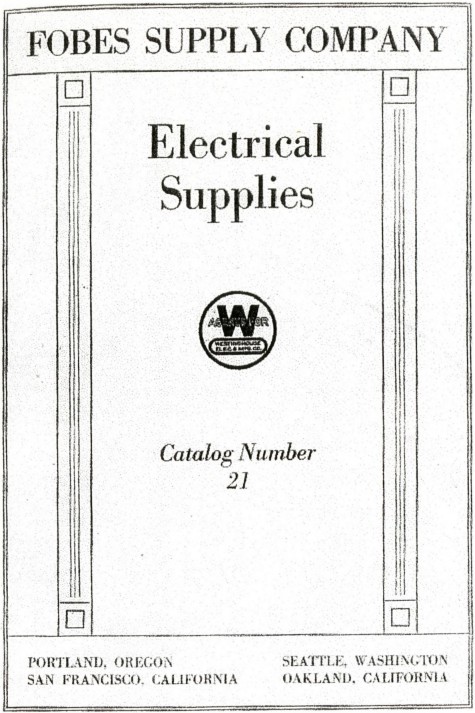
Source: National Museum of American History
The Case for Santa Fe
Chartered in Topeka, Kansas in 1859 as the Atchison, Topeka and Santa Fe
Railway System, by the year's end, 1900, the company owned and operated over
8,128 miles of track serving ten western states. (Attachment 3) When you consider
the miles of signal and telegraph lines associated with such a spread it would seem to offer a huge market for a glass insulator product.(5)
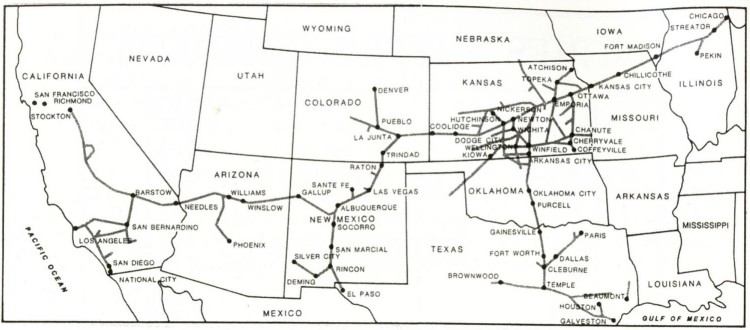
The Santa Fe System in 1900. Some branches have been deleted.
Source: Men of
the Steel Rails, James Drucker, University of Nebraska Press, 1983
The Santa Fe operated Stores Departments that maintained inventories of items
used by the system. Major and minor Stores Departments were located wherever the
system had major yards or shops.(7) When ordering any required material (i.e.
poles, wire, insulators, etc.) these departments consulted an industry-wide
source known as "The Maintenance of Way Cyclopedia." Unfortunately,
this resource was not available prior to 1921. (9)
Before that time, items that could not be obtained locally would be ordered
directly from manufacturers for on-site delivery. Remember, the Santa Fe was
reported as being a customer of the California Glass Works.(4)
The Atchison, Topeka & Santa Fe Railway may have requested S.F. embossing
on their insulators since the Santa Fe logo was adopted in 1901, several years
prior to the founding of the California Glass Works (1914). There is cause for
skepticism though because few, if any, of the aforementioned California Glass
Works customers received unique embossings.
The Case for Brookfield
The connection of Brookfield to the S.F. embossed insulators is neither
obvious nor direct. Certain CD102 STAR insulators are unique in that they have a
raised dot under one arm of the star embossing. These same STAR insulators were
believed to have been Brookfield products due to the color and quality of the
glass, dome numbers and drip points. Serious collectors noted a similarity of
the dot location and the last period of the S.F. embossing. In both cases, the
dot was located .8 cm above the base mold line, a striking coincidence. Could
the STAR insulators have been made from reworked S.F. molds? How did Brookfield
came to be using molds heretofore believed to be Harloe Glass molds from Hawley,
Pa. and Elmer, NJ? History provides the answer by recording that Harloe sold
their molds to Brookfield in October of 1907.
Conclusions (?)
As was said at the opening, the jury is still out. Some factors lean in the
direction of the Pacific & San Francisco Glass Works in the 1886 to 1889
period. The sign at the 1877 exposition indicates that they did, in fact, use
the S.F. abbreviation in their title.
S. F. Comparisons
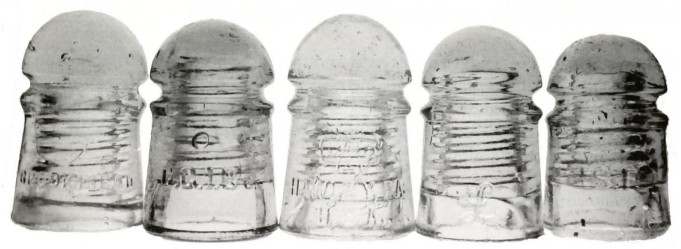
CD 102 Brookfield, C.G.I CO., Harloe, Sterling, S.F.
photo by Mike Corn
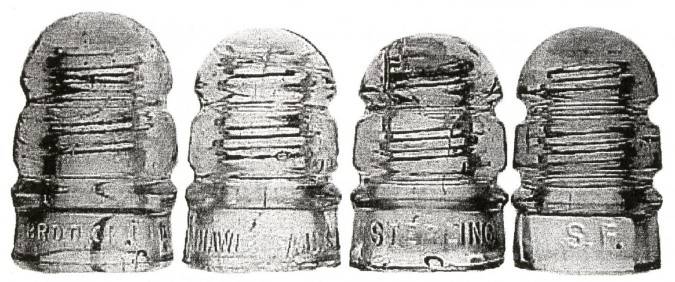
CD 112 Brookfield, Harloe, Sterling, S.F.
The California Glass Works of Long Beach did produce a large variety of
Insulators. They could have made S.F. embossed insulators for their San
Francisco customers since they did operate their own foundry and mold making
shops.(4) It would be nice to know who the unknown "San Francisco
firm" was and if unique embossing was provided.
The S. Fobes belief finds no reinforcement. The Fobes company was an agent
and distributor for Westinghouse and their catalogs fail to list S.F. embossed
insulators. Westinghouse catalogs showed Brookfield insulators. No mention is
made of S.F.
It is true that Santa Fe required large quantities of insulators but the
suppliers are not known. The route map(6) shows a wide potential for local, or
more familiar suppliers. It is interesting to note that S.F. marked insulators
are not reported as being found in Kansas, where the railway originated but are
reported as being found in areas not served by the railway.
There are some who believe that the S.F. embossed insulators were Brookfield
products and this seems quite plausible, however, William L. Brookfield did not
recall production of S.F.. insulators. (8) Excavators at Hemingray, Brookfield
and Novelty Glass sites did not report finding S.F. remnants.(9)
Unfortunately, there seem to be no hard and fast indicators of manufacture
and it must be left to future researchers to uncover the S.F. sources. A
side-by-side comparison of the suspected manufacturer's CD 112s and CD 102s is
provided in attachment 4. (Note the similarities and dissimilarities.) As the
hucksters on the midway at the county fairs used to say
"You pays your money and you takes your pick"
Footnotes:
1. Bottles and Extras Magazine. The Early Fruit Jars of the Pacific and San
Francisco Glass Works, By Dave Hinson and Alex Kerr, , July, 1995
2. Antique Western Bitters Bottles, By Jeff Wichmann
3. History and Guide to North American Pin Type Insulators, By John &
Carol McDougald, Vol. 1, pg. 85
4. Crown Jewels of the Wire Magazine. The California Story, By Ted Griffin,
September, 1982
5. Santa Fe. The Railroad that built an empire. By James L. Marshall
6. Men of the Steel Rails. Workers on the Atchison. Topeka & Santa Fe
Railroad 1896-1900. By James H. Ducker
7. AT&SFRR History Website, Mike Martin, Oct.22, 2005
8. Crown Jewels of the Wire Magazine. A Conversation with William L.
Brookfield, By Carol McDougald, December, 1999
9. Personal Contacts:
E. Gish, 1-19-05 email (re: Brookfield)
R. Klingensmith,
2-27-05 email (re: Novelty)
R. Stahr, 4-16-05 email (re: Hemingray)
D. Allen,
11-23-05 email (re: M.O.W.Cyclopedia)
10. Puget Sound Regional Archives, Philip Stairs, Archivist
11. The Glass Insulator in America. 1988 Report by N.R.Woodward, chap.8
12.
Simon Fobes; The Life of a Revolutionary War Soldier, National Archives
References:
Maintenance Of Way Cyclopedia. 1921, American Railway Engineering
Assoc.
| 